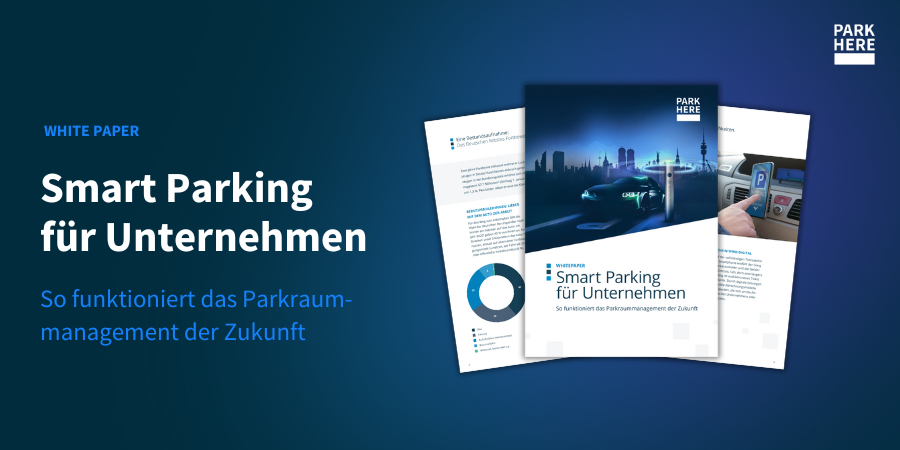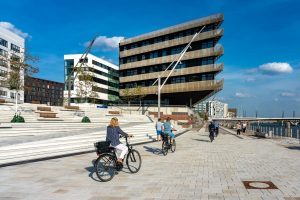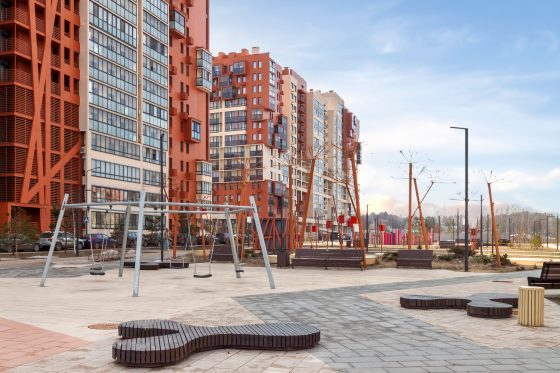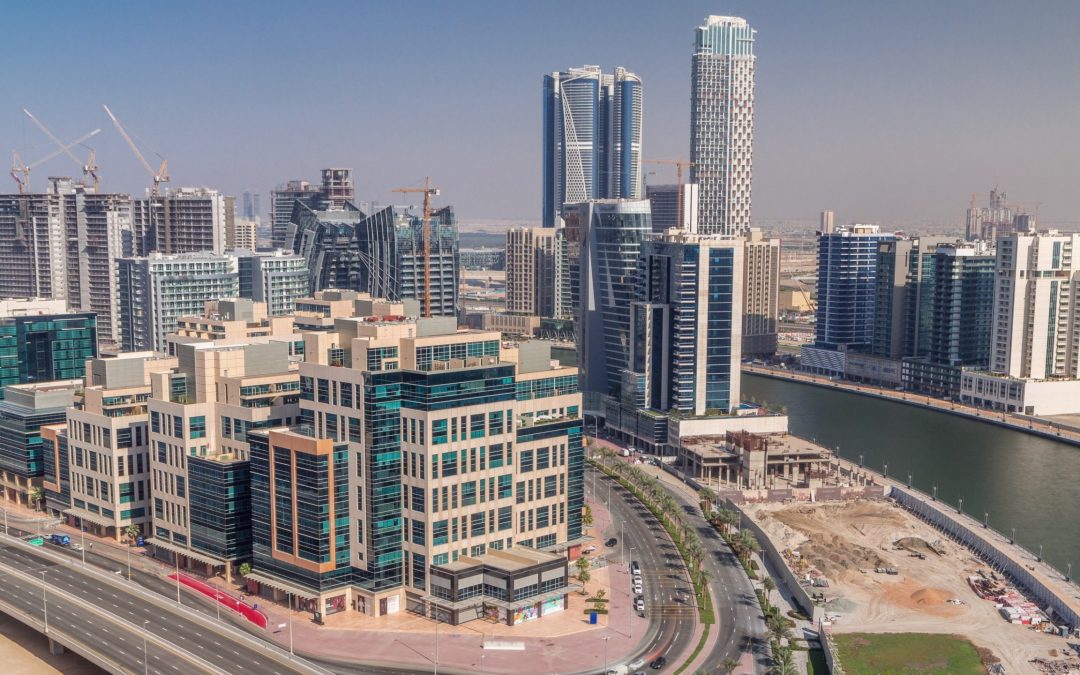What are Mixed-Use Properties?
Mixed-use properties contain various forms of use under one roof – for example, commercial space for retail, living space, offices, leisure facilities and services. In contrast to classic residential or office buildings, mixed-use properties are not limited to one area of life, but offer space for different usage concepts.This ensures short distances and saves resources. For example, the way home could be combined with a visit to the hairdresser, a trip to the gym or a purchase in the supermarket. Mixed-use properties meet the growing need for an urban district with flexible usage options. The term mixed-use originally comes from the USA. There,
Download our free white paper Smart Parking for Companies now and learn everything you need to know about the topic.

The Main Forms of Use of Mixed-Use Properties are:
- Offices and co-working spaces
- Living spaces
- Shopping centers
- Educational institutions
- Hotels
In Addition, there are Supporting Forms of Trade:
- Parking
- Food retail
- Medical practices
- Fitness studios and wellness centers
- Gastronomy
- Entertainment (cinema)
- Services (hairdresser, craftsmen, laundromat)
The Offer of Mixed-Use Properties is Supplemented by Public-Related Use, for Example:
- Green spaces and parks
- Playgrounds
- Daycare centers
- Libraries

Mixed-use Properties: an Emerging Asset Class
Mixed-use properties not only increase the quality of life of urban districts, but also have decisive advantages for investors.Due to their different types of use, mixed-use properties offer a broad diversification of risk. Fluctuations in individual markets do not affect the entire property. Industry slumps in certain market segments are cushioned; a complete loss of rent or vacancy is not to be feared. This ensures a steady cash flow. The success of mixed-use properties is not measured by short-term market trends, which makes them an increasingly popular asset class.
A look at the figures shows the sustainability of mixed-use properties: While the market share of the transaction volume on the commercial market was around five percent in 2017, it was already eleven percent in 2018. This trend is reinforced by the Corona pandemic and the associated lockdowns: The HAHN Retail Real Estate Report 2021/2022 records an increased interest in mixed-use properties and predicts an increase in demand and supply.
Reasons for the Success of Mixed-Use Properties are:
- Urbanization: Since industrialization, more and more people have been living and working in the city. Affordable housing and office space are becoming scarce. In contrast to large housing estates on the outskirts of the city, which can become social hotspots, and office complexes that are empty at night, mixed-use properties are used around the clock and are attractive to various target groups.
- Mobility behavior: A good inner-city infrastructure and connection is an important factor for many people. The bundling of living, working, leisure and supply in one place meets the needs of the modern city dweller. The short distances are environmentally friendly and conserve resources.
- Scarcity of building land: In view of the scarcity of building land in cities, the mono-use of buildings is considered inefficient and no longer fits the concept of the urban quarter. Mixed-use properties react to the changed needs and can combine trends from individual segments, for example co-working spaces and barrier-free living.
In Order to Make a Mixed-Use Property Competitive, some Aspects should be Considered:
- Location: The choice of the right location is of central importance for the success of a mixed-use property. It is important that the location fits all forms of use of the building.
- Investment amount: A higher investment amount must be expected for the acquisition of a mixed-use property than for a pure residential property. But the return also increases.
- Choice of tenants: How attractive a mixed-use project is depends largely on the selection of the usage offer. Finding the perfect mix of uses can be a challenge. Tenancy relationships should be as financially sound and long-term as possible. Nevertheless, it can be worthwhile to bring smaller socio-cultural associations on board, which exploit the creative potential of the quarter idea.
- Asset management: The diversity of use means an increased coordination effort. Each tenant requires a different approach and support. This leads to higher administrative costs.

Urban Area: New Paths in Urban Planning
The ongoing urbanization trend is leading to a rethinking in urban planning: Since 2017, there has been the planning law category "urban area."This new area category is intended to enable a high structural density and diversity of use in urban areas. Accordingly, urban areas serve for living, but also for the accommodation of commercial enterprises and social, cultural and other facilities. Mixed-use properties meet these framework conditions and are suitable for the expansion of a district to the urban quarter.
Characteristic of an urban quarter is not only the practical aspect of the short distances, but the attitude to life that it transports. "Urban" here stands for cosmopolitanism, tolerance and freedom. The colorful mix of living space, leisure areas and local supply enables individual use of the individual offers. Urban quarters offer on the one hand free development in the anonymity of the big city, on the other hand they can be a place for identity formation and home.
Mobility in the Urban Quarter
The urban infrastructure and an intelligent mobility concept form the basis for successful mixed-use projects in the urban quarter. A densification of the cities means maintaining all important services and functions with an increasing population.Building blocks of an intelligent mobility concept are:
- Public transport: Public transport is the central element of future transport planning for many cities. The expansion of public transport is intended to have a traffic-calming effect and at the same time ensure mobility within the urban area.
- Long-distance transport: The proximity or good connection to train stations, bus stations, transport hubs and airports ensures the accessibility of the urban quarter from outside.
- Parking garages and underground garages: Parking areas absorb the stationary traffic and increase the quality of stay in the urban quarter. Innovative concepts such as quarter garages, which are used by residents and visitors, supply several properties at the same time. Underground garages save space in the urban area for other uses; above-ground parking garages offer space on the roof for climate-friendly facilities such as solar cells and green spaces.
- Sharing-Models: The provision of rental bikes, e-scooters and car sharing promotes mobility in urban areas and ensures fewer private vehicles that take up space.
Conclusion: Added Value through Mixed-Use
Mixed-use properties bundle different usage offers in one place. They are mainly used for living space, office space, commercial space, shopping centers, educational institutions and hotels. The usage mix is supplemented, for example, by service providers, medical practices and leisure areas.Mixed-use properties and urban quarters correspond to the zeitgeist and react to today's challenges. They contribute to the attractiveness of inner cities and meet a wide range of needs through their diversity of use.
For investors, mixed-use properties are interesting because they enable excellent risk diversification and are independent of the development of individual market segments. In recent years, mixed-use projects have been able to continuously increase their market share.
Of central importance for urban quarters are intelligent mobility concepts. Elements of a sustainable transport planning are public transport, long-distance transport connections, underground garages and parking garages as well as sharing models. That mixed-use properties will completely replace classic residential and office buildings in the future is not to be expected. Nevertheless, they are establishing themselves on the market as an attractive asset class and offer considerable added value for both investors and users.
Would you like to learn more about Smart Parking? In our Download Center you will find further information, success stories and tips. Put it in first gear and come and have a look!

If you would like to receive regular information from ParkHere, please fill out the form and stay informed about the latest mobility topics.
